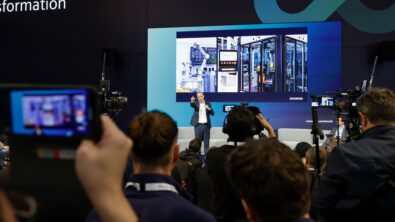Redefining engines with manufacturing simulation
 When our customer, Perkins Engines Company, asks the question, “Who says you can’t have it all?”— as they do in the marketing material for their Tier 4 engines – they’re referring to the trade-off between emissions legislation and customer demands, and making the case that it’s possible to satisfy both sets of requirements in a single diesel engine.
When our customer, Perkins Engines Company, asks the question, “Who says you can’t have it all?”— as they do in the marketing material for their Tier 4 engines – they’re referring to the trade-off between emissions legislation and customer demands, and making the case that it’s possible to satisfy both sets of requirements in a single diesel engine.
Perkins’ customers (heavy equipment OEMs) want performance and fuel economy, along with other features such as durability and a good price. Emissions legislation, on the other hand, forces Perkins to continually reduce particulate matter, nitrogen oxides, hydrocarbons, and carbon monoxide in engine emissions.
Perkins’ 80-year history of engineering expertise goes a long way toward finding the balance between often conflicting sets of design criteria. The company also has a very proactive way of working with customers to determine what they want and need.
Balancing conflicting requirements in an engine design is just half the challenge, however. Eventually, the engine must be built. Perkins engines are produced using the latest manufacturing technologies, which you can see in the first minute of this video.
In the mid-2000s, when Perkins was at this point with the Tier 3 engine the company turned to Cliff Gillis, who was then manufacturing technology and systems manager, the person responsible for getting manufacturing facilities ready to produce new products. (Gillis is now a senior project manager leading Global Projects Portfolio in the Order to Delivery Technical Services Organization.)
Gillis, a big believer in digital manufacturing simulation, established a process called virtual process planning for assembly (VPPA). “The stakes were high,” Gillis recalled. “Late-stage changes to expensive tooling or production processes would increase the risk of escalating costs and disrupt current production schedules, which could result in missed delivery commitments.”
The idea behind VPPA was to create a digital representation of a Tier 3 engine assembly process (starting with their award-winning Peterborough, UK facility). They would then fine-tune the assembly in software so that late-stage changes wouldn’t be required when real engines began to be built.
VPPA is built on a number of Siemens PLM Software products. In addition to Teamcenter, VPPA incorporates several products from the Tecnomatix suite, including Plant Simulation discrete-event simulation software, FactoryCAD factory layout software, and Jack human simulation software.
Tecnomatix Plant Simulation software generates what Perkins calls a “virtual build event” that builds the engine in the actual production line sequence. Production planners can manipulate the virtual build event, to observe various what-if scenarios, for example.
VPPA was a huge success for the Tier 3 engine program, preventing “a significant number of issues that would have had a substantial cost impact later on, had they reached production,” Gillis said.
Once actual production of Tier 3 engines started, the number of issues was significantly lower compared to previous new engine assemblies. “And the team picked up all the major concerns that previously would have caused major disruption in the factory,” Gillis added. “Potential clashes with machines were identified; rigging equipment for engine tests was designed; and the engine-dispatch equipment was also designed and rationalized.”
On the basis of that success, Perkins made VPPA a structured process within the organization, and it was used in the process planning for the Tier 4 engines as well. You can find more information about Perkins and VPPA in the case study, Widespread adoption of virtual simulation and process planning yields big dividends.Who says you can’t have it all? (Read a summary here and get more detail there.)
Editors Note: Interested in learning more about Tecnomatix? Join our webinar on Essentials for Excellence in Machinery and Heavy Equipment Manufacturing. And, be sure to visit the Tecnomatix Community to stay informed about our latest product news and highlights.


